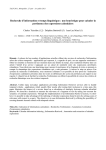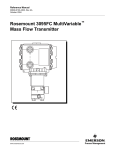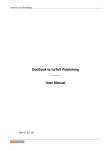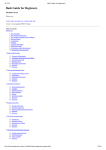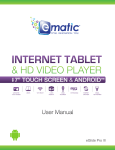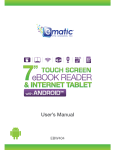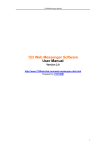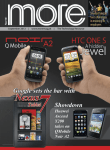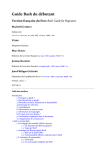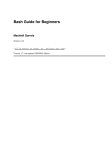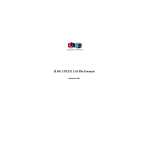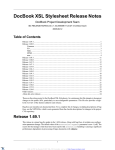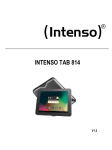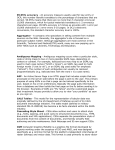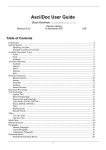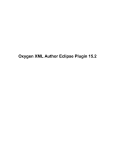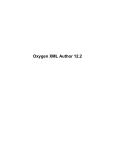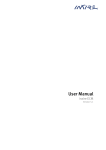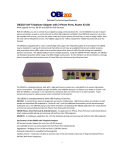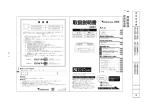Download software documentation - BRAC University Institutional Repository
Transcript
Software Documentation
A Thesis
Submitted to the Department of Computer Science and Engineering
of
BRAC University
by
Tahmina Zaman Khan
ID: 02101083
CS
In Partial Fulfillment of the
Requirements for the Degree
of
Bachelor of Science in Computer Science
August 2006
Declaration
I hereby declare that this thesis is based on the results found by myself. Materials of work
found by other researcher are mentioned by reference.
Signature of Supervisor
Signature of Author
Acknowledgement
It was my great pleasure to be able to conduct a research work and complete the thesis
paper on “Software Documentation”.
I would like to extend my sincere thank to my supervisor Dr. Mumit Khan, Associate
Professor, CSE Dept. BRAC University, Dhaka for his precious time and perpetual
support extended relentlessly to fulfill my academic assignment.
Also I honor his immense contribution throughout the process of study. His contribution
in the preparation of the concept paper, literature, methodology and writing this report is
highly acknowledged. I am immensely grateful to him for his extensive assistance.
I am also thankful to my co-supervisor Mr. Matin Saad Abdullah for his helpful and
appreciable assistance at the beginning of the study and clearing the subject matters.
Tahmina Zaman Khan
02101083
CSE Dept.
BRAC University.
Abstract
The main objective of my thesis is to generate a user manual that would be very much
comprehensible at the same time well structured and would act as an effective navigator.
Documentation is mainly requisite for better communication among the different
members of a software development team, such as designers of finer grained components,
builders of interfacing system, implementers, testers, performance engineers, technical
managers, analysts, quality specialists. In order to develop a very comprehensive
documentation there are certain conventions that are requisite to be taken care of. Those
conventions and rules have been high lighted extensively.
There are different types of documentation based on the requirements of each individual
associated with the software development life cycle and they are design, code, user,
architectural, trade study and marketing are few to mention.
However, my focus area is user documentation. Unlike code documents, user documents
are usually far divorced from the source code of the program, and instead simply describe
how it is used. The use of XML and Docbook is there. DocBook simply provides a
framework. All the presentation issues are devolved to style sheets.
Contents
Topics
Pages
Declaration
Acknowledgement
Abstract
Chapter 1: Introduction
Chapter 2: Some basic rules to software documentation
2.1 Importance of audience
2.1.1 Examining the software to determine the user base
2.2 Importance of Writing Procedures
2.2.1 The importance of word choice and consistent writing
01-02
03
03
03-04
04
04-05
2.2.2: Use active language
05
2.2.3 Use short phrases and sentences
06
2.2.4 Use ordered lists
06
2.2.5 Provide one instruction per step
07
2.2.6 Be consistent
2.3 The importance of organization
2.4 The importance of indexing
2.5 The importance of editing and review
Chapter 3: Architectural Documentation
3.1 The Views and Beyond Approach to Software Architecture Documentation
07-08
08-09
09
09-10
11-13
13
3.1.2 A Multi-View Approach
13
3.1.3 Different Kinds of Views
14
3.1.4 Styles
14-15
3.1.5 Choosing the Views
15-16
3.1.6 A Template for Views and Information beyond Views
16-20
3.2 1471 (IEEE Recommended Practice for Architectural Description of Software-
20-23
Intensive Systems)
3.3 The “4+1” View
Chapter 4: User Documentation/ Manual
23-29
30-31
4.1 The following is a generic user manual structure
Chapter 5: Best Practice Method For Generating Effective user documentation/ manual
5.1 Mark up: General Overview
5.2 What is DocBook
5.3. DocBook Modules
31
36
36-39
39
41-47
5.4 Software Packages requisite for DocBook
47
5.5 Users of DocBook
48
5.6 When is DocBook appropriate?
49
5.7 When is DocBook not appropriate?
49
Chapter 6: Distinctive features of DocBook
50-52
6.1 Output formats
52-54
Chapter 7: Command Used
54-63
Chapter 8: Customizing DocBook document using style sheets
63
Chapter 9: Test Case: BanglaPad
75
9.1 Background
75
9.2 Application (HTML Version)
76
9.3 The Manual in RTF
78
9.4 The Manual in PDF
79
9.5 The Manual in Post Script
80
Chapter 10: After Customization
81
Chapter 11: Conclusion And Future Work
83
References
85
List of Figures
Name of the Figures
Page
Figure 3.1 The Template for a View
18
Figure 3. 2: The Template for Documentation beyond Views
20
Figure 3.3: Excerpt from Conceptual Framework of 1471
22
Figure 3.4: shows the five views of the 4+1 view model.
24
Figure 3.5: A class diagram of an ordering system
26
Figure 3.6: A collaboration diagram of an ordering system
26
Figure 3.7: A package diagram shows how packages are nested in the system
27
Figure 3.8: A deployment diagram of an ordering system
29
Figure 5.1: General Overview of DocBook components
38
Figure 5.2: Docbook XML Publishing (XSLT)
39
Figure 5.3: Structure of the DocBook DTD
41
Figure 6.1: Docbook to other output formats
53
Figure 9.1: Front page (html version)
75
Figure 9.2: Front page of the User Manual
76
Figure 9.3: The second page
77
Figure 9.4: “How to open a file” page of the User Manual
77
Figure 9.5: Cover Page
78
Figure 9.6: TOC
78
Figure 9.7: PDF version of User manual
79
Figure 9.8: A page of “Change font”
79
Figure 9.9: Cover page
80
Figure 9.10: TOC
81
Figure 10.1: Customized HTML Version
81
Figure 10.2: Customized First Page
82
Figure 10.3: Customized Middle Page
82
CHAPTER 1: INTRODUCTION
Software Documentation
It is stated that any document (hardcopy or softcopy) which defines the functional
requirements, design, implementation, operation or support arrangements that
pertain to a software item or any data used by a software item is known as
software documentation. Essentially it is written text that accompanies computer
software. It either explains how it operates or how to use it. In fact, the term
software documentation means different things to different people. It is mainly
requisite for better communication among the different members of a software
development team, such as designers of finer grained components, builders of
interfacing system, implementers, testers, performance engineers, technical
managers, analysts, quality specialists. The goal of software documentation is to
provide a framework and model for recording the essential information needed
throughout the development life cycle and maintenance of a software system.
However, all documentation must be done abiding by certain basic rules for the
convenience of the readers and this will be described shortly. There are different
types of documentation meant to cater different categories of users. Such as:
Architectural: merely lays out the general requirements that would motivate the
existence of a routine. A good architecture document is short on details but thick
on explanation.
User: describes how the software is used.
Code: text attached intended to explain various operations. This writing can be
highly technical and is mainly used to define and explain the APIs, data
structures and algorithm.
Design: takes a much broader view and emphasize on WHY the concerned
software is designed in that manner.
Trade study: It focuses on one specific aspect of the system and suggests
alternate
approaches. It could be at the user interface, code, design, or even architectural
level.
Marketing: used to allure the potential user, explain the product’s functionality,
and focus on the position of the product in comparison to other alternatives.
Nevertheless, different methodologies are there for each of the aforementioned
approaches to documentations, where few of them have been covered in this
paper. EEE/ANSI 1471, View and Beyond (V & B) and 4 + 1 Model are few to
mention. These mainly focus the architectural view of the software.
This paper mainly is designed to encompass every nook and corner of the user
documentation and tool and techniques associated with in creating an effective
and efficient user manual. Which would enable any and every user to get
benefited; in short it is aimed to create a very helpful navigator. In order to deal
with the formatting and structuring of the document consistently, maintaining
cohesiveness all along the way, DocBook has been incorporated. DocBook
simply provides a framework and all the presentation issues are devolved to style
sheets. DocBook has its own set of tags, processing tools and transformation
tools.
CHAPTER 2: BASIC RULES FOR SOFTWARE DOCUMENTATION
2.1 The importance of audience:
The audience is a key element that many people fail to consider. When the job is
to convey knowledge to someone, we need to understand what that person
already knows and develop a sense of the teaching methods likely to work for
that person. If it is a writing instruction for a customer service representative it is
better not to assume they understand database theory or any of the associated
terminology. It sounds obvious, but the failure to properly analyze intended
audience is the single largest pitfall facing technical writers.
2.1.1 Examining the software to determine the user base
If we don't understand our audience then chances are we won't be able to write
documentation they'll understand. Evaluating the audience can be a difficult task
but it is absolutely essential to do so. The best way to start analyzing the
audience is by evaluating the product we need to document. Quite a lot about our
intended audience can be told from the software since they are also the intended
users of the software.
If we're tasked with teaching developers how to write front ends for the product
using Visual Basic, then we already know quite a lot about our audience. We
know that:
They are developers
They know Visual Basic
They are familiar with user interface design
In actuality, perhaps some of the readers will not fit this description, but it is our
task to define the supported skill set, make it clear to the readers what we expect
them to already know, and then write the book as if they know precisely that - no
less and no more. If some of the readers do not meet all of the prerequisites
we've set out for the book then it is their responsibility to gain those skills before
attempting to use our book.
In some cases, our intended audience will not be so clearly defined. Parts of the
book may include overview information while other parts delve deep into the
inner workings of the product. In these cases we'll need to work particularly hard
to develop a list of things and terminology all of the readers will understand, and
perhaps divide the book into several sections for analysis. Just it should be made
sure to clearly state whom each section is intended for within the introductory
material of the documentation.
2.2 Importance of Writing Procedures
Most technical writers spend at least part of their time writing procedures.
Procedures are essentially detailed instructions for performing one or more tasks.
Unless the documentation is strictly conceptual (explaining a topic rather than
telling the readers how to use the software), it is required to write procedures.
Since readers will be following instructions on real applications with real data, it is
particularly important that our directions be clear, concise, accurate, and easy to
follow.
2.2.1 The importance of word choice and consistent writing
A good technical writer not only understands his/her intended audience, s/he
understands the importance of clear and concise writing. Although most writers
dream of beautiful prose that can move readers to another plane of existence,
technical writing is all about removing any possible ambiguities so the reader
understands precisely what to do. Short descriptive active sentences are
generally better than long flowery lines filled with metaphor. Word choice is
paramount to a technical writer. If there is any possible way an instruction can be
misread or misconstrued someone will do so. When possible consequences of
wrong actions are data corruption and data loss it becomes very important that
users understand what we are telling them to do.
Consistency is also important. If we lead our users to expect all functions to
appear in boldface followed by a set of parentheses, then it must be made sure
all functions appear that way. Otherwise, the readers may not realize that they're
all functions and could get confused. Similarly, we should keep a similar style
and vocabulary throughout each document. If we’re writing an introduction filled
with very general and basic conceptual material we must make sure to avoid as
much technical terminology as possible and that we always define all terminology
used. If several writers are collaborating on the same document it must be made
sure that individual voice doesn't shine through. When the document is finished
we should not be able to tell where one person stopped and another picked up.
We shouldn't even be able to tell that more than one person worked on the
documentation.
2.2.2: Use active language
A procedure tells a reader to perform a specific action or set of actions. Good
instructions use active language, commanding the reader to act rather than
discussing actions that have been taken or could be taken by others. There's a
big difference between saying "the dropdown box in the corner of the page can
be used to select the date" and "select a date using the dropdown box in the
corner". The first informs the reader what that particular dropdown box does and
the second tells them to do it. The text introducing a procedure can discuss when
to perform the procedure; the procedure itself needs to tell the user how to do the
needed actions and assume that they are, in fact, doing them.
2.2.3 Use short phrases and sentences
It's important to give each instruction as clearly as possible. The fewer words
used to convey a particular task, the less places there are for a user to get
confused. Anyplace if it is possible to use a single word to convey an action, it is
best to do so.
Avoid any elaboration or explanation within the procedure itself. If we need to
provide options or explain why a particular task is important, we should do it in
paragraph form before beginning the procedure. If the user can choose more
than one way to perform a specific task, it is better to present each procedure
separately after explanatory text discussing when that particular option is a good
choice.
2.2.4 Use ordered lists
By definition a procedure consists of a set of tasks that need to be performed in a
specific order. By presenting these tasks in an ordered list, with steps 1, 2, 3,
etc., it reinforces the need to follow a set order. Numbered lists have an ingrained
implied order that's almost subconscious and thus provide much stronger
impetus that simply supplying paragraphs filled with "Do this then do that"
terminology.
Ordered lists also help bone down the language to its simplest, and thus clearest,
form. By removing all of the extraneous connective words needed to indicate
order in paragraph form it is best to remove verbiage that could confuse the
readers.
2.2.5 Provide one instruction per step
One of the common mistakes people make when writing procedures is trying to
stuff several steps into one line. They think that each instruction is simple so they
can safely combine a few easy directions into one combined step. Unfortunately
no matter how simple those individual instructions are any step that tells us how
to do more than one thing is potentially confusing. Avoid that confusion by
limiting each step to one instruction no matter how simple or mundane. For
instance, when telling users how to create a new account you could say:
Enter the desired username and password into the appropriate fields
Select the desired permissions for the new user
Hit enter to add the user
But this is clearer:
1.
Enter the desired username in the username field
2.
Enter the desired password in the password field
3.
Select the Read checkbox if this user has read privileges
4.
Select the Write checkbox if this user has write privileges
5.
Select the Exec checkbox if this user has execute privileges
6.
Hit enter to add the user
2.2.6 Be consistent
Consistency is important in all documentation, but especially so when writing
procedures. In particular, it is paramount to use consistent names for screen
elements like buttons, forms, tabs, and windows. Many of these elements won't
be named within the software so we'll have to name them. Choose a logical
name that makes it obvious what particular element we're referring to and then
propagate that name throughout the entire documentation set.
Collect all of the names created and is required to make sure they're added to a
common database of product terminology. In an ideal world, these terms would
be added to a group style guide or glossary, but even if we don't do that, is it
needed to make sure that they are preserved and available to everyone working
on that product.
Don't feel like we need to come up with ten creative ways to tell people how to
press a button. Tell them to press the button (or tap it, or choose it, or whatever
terminology we've decided on) each and every time. We shouldn't break out the
thesaurus, but rather use repetitiveness to really pound home clarity.
In addition to consistent use of names and terminology in general, it's also
important to use parallel constructs within the procedures. The human brain
looks for parallelism and is bothered when it's not there (even if it doesn't
completely understand what's wrong with a particular sentence). By beginning
each step with a similar phrase and tone, we're allowing the user to ignore the
writing and concentrate on the content.
2.3 The importance of organization
Technical writers tend to pay more attention to organization and the order
material gets presented than most other writers. In many cases, other writers
have some leeway in presentation. More often than not the material can be
organized in several different ways and still retain its effectiveness. This is not
often true for technical writing. Since much of the time we're either providing
instructions - by their very nature a series of ordered steps - or providing
background information that builds on prior material and tasks already completed
organization is extremely important. If we fail to give users an essential step of
any procedure they will not successfully complete that procedure. If we fail to
discuss a basic topic before moving on to a related advanced topic they most
likely will get confused.
It's our job to analyze everything the user needs to do to successfully use a
product and determine the order they need to do those items. Then we need to
determine what the user is likely to already know and make sure that we provide
every other scrap of needed information. In addition we must analyze how
someone who doesn't understand the product as well as we does would think
about the product and provide logical entry points to the necessary material given
those expectations. It doesn't help to provide every scrap of information our users
need if they can't find that information within our document
2.4 The importance of indexing
Indexing is an important but often overlooked step in this process. Most users are
going to either turn directly to the table of contents or turn directly to the index
and start looking for the material they think they need. We need to make sure
that information can be found from either method even if the user doesn't yet
know precise terminology or an exact word to look up. Cross-indexing is an art,
one that eludes many otherwise very competent technical writers. Indexing is a
skill that needs to be developed and practiced regularly.
2.5 The importance of editing and review
We might think the process of technical writing is complete once the last word is
put on the page, but it isn't. Every document needs to be reviewed and edited. In
some cases we'll be fortunate enough to have an actual editor in place to edit our
document, but most technical writers must rely on another technical writer or
even do it themselves. In addition to the normal editing tasks of checking
grammar, general word usage, and spelling, technical editing includes several
other elements including checks for consistent word usage, checks that a
consistent audience is maintained, and checks that the organizational choices
make sense.
Reviewing often occurs at the same time as the editing process but it serves a
very different purpose. While editing ensures a clean grammatically correct
document with consistent style, it doesn't test the accuracy of the content in any
way. Reviewing does. If possible, we should have at least one of the developers
who wrote the product participate in a review as well as at least one person who
fits the target audience profile. If the person within the target audience doesn't
understand everything we wrote then even if it's accurate we haven't successfully
met your mandate and need to re-write the document accordingly. If the
developer finds inaccuracies or points out areas where the product was changed
then similarly we need to fix those before declaring the document finished.
CHAPTER 3: ARCHITECTURAL DOCUMENTATION
Software’s architecture for a program or computing system consists of the
structure or structures of that system, which comprise elements, the externally
visible properties of those elements, and the relationships among them the
quality attributes of a software system, such as performance, modifiability, and
security, are bound up in its software architecture. A system with the wrong
architecture will be a failure.
Software architecture also determines the blueprint for the project developing the
software. Teams are formed around architectural elements, which are the units of
implementation,
unit
testing,
integration,
configuration
management,
documentation, and a host of other activities.
Unlike code, architecture is a design artifact largely intended for use and analysis
by humans. Hence, representing it in a readable, accessible fashion for its
stakeholders becomes an issue of importance. Architecture gives the marching
orders to implementers, telling them what pieces to build and how those pieces
should behave and interact with each other. It also determines the project
structure for managers, who use it to plan, schedule, and budget. It gives the first
glimpse of the system to maintainers who must change the architecture and new
team members who must become familiar with it.
Therefore,
architecture
documentation
has
emerged
as
an
important
architecture-related practice. In 2002, researchers at the Carnegie Mellon
Software
Engineering
Institute
(SEI)
completed
Documenting
Software
Architectures: Views and Beyond, which puts forth a documentation philosophy
as well as a detailed approach. The philosophy is embodied in the title: "views
and beyond." The V&B approach, as it is known, holds that documenting
software architecture is a matter of choosing a set of relevant views of the
architecture, documenting each of those views, and then documenting
information that applies to more than one view or to the set of views as a whole.
The last step ties the views together and makes them become a holistic and
integrated representation of the architecture, as opposed to disjoint snapshots
taken from different angles. The detailed approach includes a method to choose
the most relevant views, standard templates for documenting a view and
documenting the information beyond views, and definitions of the templates'
content.
While the V&B approach was being solidified, a new recommended best practice
was being formed by the Institute of Electrical and Electronics Engineers (IEEE).
The IEEE Architecture Planning Group (APG) was formed in August 1995 and
chartered by the IEEE Software Engineering Standards Committee (SESC) to set
a direction for incorporating architectural thinking into IEEE standards. The result
of the APG's deliberations was to recommend an IEEE activity with goals as to
define useful terms, principles, and guidelines for the consistent application of
architectural precepts to systems throughout their life cycle, to elaborate
architectural precepts and their anticipated benefits for software products,
systems, and aggregated systems ("systems of systems"), to provide a
framework for the collection and consideration of architectural attributes and
related information for use in IEEE standards, to provide a useful roadmap for the
incorporation of architectural precepts in the generation, revision, and application
of IEEE standards
In April 1996, the SESC created the Architecture Working Group (AWG) to
implement those recommendations eventually became ANSI/IEEE Std. 14712000]. That standard, henceforth referred to as 1471, is a recommended practice
that addresses the activities of the creation, analysis, and sustainment of
architectures of software-intensive systems and the recording of such
architectures in terms of architectural descriptions. The standard establishes a
conceptual framework for architectural description and defines the content of an
architectural description.
Interest in 1471 is growing and will likely continue to grow. Although it is
impossible to tell how many projects invoke it, it is mandated for use in the Future
Combat Systems (FCS) project, a U.S. Army command-and-control system that
is expected to comprise over 30 million lines of code and (therefore) whose
software architecture is of supreme importance.
3.1
The
Views
and
Beyond
Approach
to
Software
Architecture
Documentation
3.1.2 A Multi-View Approach
Modern software architecture practice embraces the concept of architectural
views. A view is a representation of a set of system elements and the relations
associated with them. Views are representations of the many system structures
present simultaneously in software systems. Modern systems are too complex to
be grasped all at once. Instead, we restrict our attention at any one moment to
one (or a small number) of the software system's structures, which we represent
as views. Some authors prescribe a fixed set of views with which to engineer and
communicate architecture; for example, the Rational Unified Process (RUP),
which is based on Kruchten's 4+1 view approach to software and the Siemens
Four Views model. A recent trend, however, is to recognize that architects should
produce whatever views are useful for the system at hand, and the V&B
approach adopts that policy. This trend leads to the fundamental philosophy of
the V&B approach stated earlier: Documenting architecture is a matter of
documenting the relevant views and then adding documentation that applies to
more than one view.
3.1.3 Different Kinds of Views
There is an almost unlimited supply of views to choose from. To lend some order
to an otherwise chaotic collection of possible views, it's helpful to think about
views in groups, according to the kind of information they convey:
Module views describe how the system is to be structured as a set of code units.
Component-and-connector (C&C) views describe how the system is to be
structured as a set of interacting runtime elements. Allocation views describe
how the system relates to non-software structures in its environment. A particular
view of a system may fall squarely into one of these categories or combine
information from more than one category.
3.1.4 Styles
A view is a representation of a structure that is present in a software system. One
might show the hierarchical decomposition of the system's functionality into
modules or how the system is arranged into layers; another might show how the
system accomplishes work through communicating processes or the interaction
of clients and servers. Still another might show how software elements are
deployed onto hardware processing and communication nodes.
An architect chooses the structures to work with and designs them to achieve
particular quality attributes using architectural styles.1 A style is a specialization
of element types (e.g., "client," "layer") and relationship types (e.g., "is part of,"
"request-reply connection," "is allowed to use"), along with any restrictions (e.g.,
"clients interact with servers but not each other" or "all the software comprises
layers arranged in a stack such that each layer can only use software in the next
lower layer").
Styles are documented in a style guide that defines each style by defining the
element types and relationship types indigenous to the style, along with any
semantic restrictions on their use. It lists what design problems the style is and is
not good at addressing. The guide also discusses any notations or analytical
approaches available to the architect using that style and refers to any related
styles.
3.1.5 Choosing the Views
The V&B approach to choosing the views to document is a simple three-step
procedure based on the structures that are inherently present in the software and
on the stakeholders and the concerns they have that would motivate
documenting the corresponding view. The steps are described below.
Step
1:
Produce
a
Candidate
View
List
Begin by building a stakeholder/view table for your project. Enumerate the
stakeholders for your project's software architecture documentation down the
rows. Be as comprehensive as you can. For the columns, enumerate the views
that apply to your system. Some views (e.g., decomposition, uses, and work
assignment) apply to every system, while others (e.g., pipe-and-filter, layered)
only apply to systems designed according to the corresponding styles.
Once you have the rows and columns defined, fill in each cell to describe how
much information the stakeholder requires from the view: none, overview only, or
detailed. We encourage architects to hold a workshop with stakeholders or their
representatives to begin a dialogue about what information they will need from
the documentation. The candidate view list consists of those views in which
some stakeholder has a vested interest.
Step
2:
Combine
Views
The candidate view list from Step 1 is likely to yield an impractical number of
views. Step 2 winnows the list to a manageable size.
First, look for views in the table that require only overview depth or that serve
very few stakeholders. See if the stakeholders could be equally well served by
another view that has a stronger constituency.
Next, look for views that are good candidates to become combined views. A
combined view shows information native to two or more separate views. A rule of
thumb is that if there is a strong correspondence between the elements in two
views, they are good candidates to be combined.
Step
3:
Prioritize
After Step 2; you should have the minimum set of views needed to serve your
stakeholder community. At this point, you need to decide what to do first. For
example, some stakeholders' interests supersede others. The project manager of
a company you are partnering with often demands attention and information early
and often, and you may want to cater to his/her needs first.
3.1.6 A Template for Views and Information beyond Views
No matter the view, the documentation for it is placed into a standard
organization or template comprising seven parts: A primary presentation shows
the elements and relationships among them that populate the portion of the view
shown in this view packet. The primary presentation should contain the
information you wish to convey about the system (in the vocabulary of that view)
first. The primary presentation is usually graphical. If so, it must be accompanied
by a key that explains or points to an explanation of the notation.
An element catalog details the elements (and their properties, including
interfaces) depicted in the primary presentation. In addition, if elements or
relations relevant to this view packet were omitted from the primary presentation,
the catalog is where they are introduced and explained.
A context diagram shows how the system (or portion of the system) depicted in
the primary presentation relates to its environment.
A variability guide shows how to exercise any variation points that are part of
the architecture shown in this view packet.
An architecture background or rationale explains why the design reflected in
the view packet came to be.
An "other information" section contains items that vary according to the
standard practices of each organization or the needs of the particular project.
Figure 3.1 The Template for a View
The final piece of architecture documentation is the information that applies to
more than one view and to the entire package. It ties together the views and
provides a holistic picture of the total design. Cross-view or "beyond views"
documentation consists of the following sections:
Documentation roadmap. The documentation roadmap is the reader's
introduction to the information that the architect has chosen to include in the suite
of documentation. A roadmap begins with a brief description of each part of the
documentation package. For each view in the package, the roadmap gives a
description of the view's element types, relation types, and property types. The
roadmap also gives a description of the view's purpose. The information can be
presented by listing the stakeholders who are likely to find the view of interest
and by listing a series of questions that can be answered by examining the view.
The roadmap follows with a section describing how various stakeholders might
access the package to help address their concerns. This section might include
short scenarios such as "a maintainer wishes to know the units of software that
are likely to be changed by a proposed modification."
View template. A view template is the standard organization for a view. Its
purpose is to help a reader navigate quickly to a section of interest. It helps a
writer organize the information and establish criteria for knowing how much work
is left to do.
System overview. A system overview is a short prose description of what the
system's function is, who its users are, and any important background or
constraints. The purpose is to provide readers with a consistent mental model of
the system and its purpose.
Directory. The directory is simply an index of all the elements, relations, and
properties that appear in any of the views, along with a pointer to where each
one is defined and used.
Mapping between views. This shows the correspondence between individual
elements in different views. Helping a reader or other consumer of the
documentation understand the relationship between views will help that reader
gain a powerful insight into how the architecture works as a unified conceptual
whole.
Project glossary and acronym list. The glossary and acronym list define terms
unique to the system that have special meaning. These lists, if they exist as part
of the overall system or project documentation, might be given as pointers in the
architecture package.
Cross-view rationale. This section documents the reasoning behind decisions
that apply to more than one view. Prime candidates for cross-view rationale
include documentation of background or organizational constraints that led to
decisions of system-wide import.
The following figure illustrates the seven pieces of cross-view or "beyond view"
documentation.
Figure 3. 2: The Template for Documentation beyond Views
3.2 1471 (IEEE Recommended Practice for Architectural Description of
Software-Intensive Systems)
1471 draws on experience from industry, academia, and other standards bodies.
The recommendations of 1471 center on two key ideas: (1) a conceptual
framework for architectural description and (2) a statement of what information
must be found in any 1471-compliant architectural description. The conceptual
framework described in the standard ties together such concepts as system,
architectural description, and view.
The following figure summarizes a portion of this framework in UML. In 1471,
views have a central role in documenting software architecture. In the standard,
each view is "a representation of a whole system from the perspective of a
related set of concerns." The architectural description of a system includes one
or more views. In this framework, a view conforms to a viewpoint. A viewpoint is
"a pattern or template from which to develop individual views by establishing the
purposes and audience for a view and the techniques for its creation and
analysis. In 1471, the emphasis is on what drives the perspective of a view or a
viewpoint. Viewpoints are defined with specific stakeholder concerns in mind,
and the definition of a viewpoint includes a description of any associated analysis
techniques.
Figure 3.3: Excerpt from Conceptual Framework of 14712
In addition to the conceptual framework, 1471 includes a statement of what
information must be in any compliant architectural description. These "shalls"
include the following:
Identification and overview information: This information includes the date of
issue and status, identification of the issuing organization, a revision history, a
summary and scope statement, the context of the system, a glossary, and a set
of references.
Stakeholders and their concerns: The architecture description is required to
include the stakeholders for whom the description is produced and who the
architecture is intended to satisfy. It is also required to state "...the concerns
considered by the architect in formulating the architectural concept for the
system." At a minimum, the description is required to address users, acquirers,
developers, and maintainers.
Viewpoints: An architecture description is required to identify and define the
viewpoints that form the views contained therein. Each viewpoint is described by
its name, the stakeholders and concerns it addresses, any language and
modeling techniques to be used in constructing a view based on it, any analytical
methods to be used in reasoning about the quality attributes of the system
described in a view, and a rationale for selecting it.
Views: Each view must contain an identifier or other introductory information, a
representation of the system (conforming to the viewpoint), and configuration
information.
Consistency among views: Although the standard is somewhat vague on this
point, the architecture description needs indicate that the views are consistent
with each other. In addition, the description is required to include a record of any
known inconsistencies among the system's views.
Rationale: The description must include the rationale for the architectural
concepts selected, preferably accompanied by evidence of the alternatives
considered and the rationale for the choices made.
3.3 The “4+1” View
This approach organizes the description of a software architecture using several
concurrent views, each one addressing one specific set of concerns.
An Architectural Model
The 4+1 view model is a useful, standardized method for studying and
documenting a software system from an architectural perspective. Software
architecture deals with the design and implementation of the high-level structure
of the software. It is the result of assembling a certain number of architectural
elements in some well-chosen forms to satisfy the major functionality and
performance requirements of the system, as well as some other, non-functional
requirements such as reliability, scalability, portability, and availability. Software
architecture deals with abstraction, with decomposition and composition, with
style and esthetics. In order to eventually address large and challenging
architectures, the model is made up of five main views
Figure 3.4: shows the five views of the 4+1 view model.
Each of the five views in the 4+1 view model highlights some elements of the
system, while intentionally suppressing others. The 4+1 view model is an
excellent way for both architects and other team members to learn about a
system's architecture. Architects use it to understand and document the many
layers of an application in a systematic, standardized way. Documents created
using the 4+1 view process are easily used by all members of the development
team.
The
first
four
views represent
the logical,
processing,
physical,
and
developmental aspects of the architecture. The fifth view consists of use cases
and scenarios that might further describe or consolidate the other views.
The logical view: describes the (object-oriented system) system in terms
of abstractions, such as classes and objects. The logical view typically contains
class diagrams and collaboration diagrams. Other types of diagrams can be used
where applicable.
The development view: describe the structure of modules, files, and/or
packages in the system. The package diagram can be used to describe this view.
The process view: describes the processes of the system and how they
communicate with each other.
The physical view: describes how the system is installed and how it
executes in a network of computers. Deployment diagrams are often used to
describe this view.
The use case view: describes the functionality of the system. This view
can be described using case diagrams and use case specifications.
The logical view
The 4+1's logical view supports behavioral requirements and shows how the
system is decomposed into a set of abstractions. Classes and objects are the
main elements studied in this view. You can use class diagrams, collaboration
diagrams, and sequence diagrams, among others, to show the relationship of
these elements from a logical view.
Class diagrams show classes and their attributes, methods, and associations to
other classes in the system. The class diagram in Figure 5 shows a simple use
case of an ordering system (or part of one). The customer can have from zero to
several orders, and an order can have from one to several items.
Figure 3.5: A class diagram of an ordering system
While useful, the class diagram hardly gives you a complete picture of the
system. For one thing, class diagrams are static, so they tell you nothing about
how the system will react to user input. For another, class diagrams are often too
detailed to offer a useful overview of the system. You can only learn so much
from studying a class diagram for a system comprised of thousands of classes.
You can use collaboration diagrams (or communication diagrams) and sequence
diagrams to see how objects in the system interact. A collaboration diagram is a
simple way to show system objects and the messages and calls that pass
between them. Figure 6 is a simple collaboration diagram. Note that each
message is assigned a number that indicates its order in the sequence.
Figure 3.6: A collaboration diagram of an ordering system
Collaboration diagrams are very practical for showing a birds-eye view of
collaborating objects in the system. If you want a more detailed window into the
system's logic you might want to try drawing a sequence diagram. Sequence
diagrams provide more detail than collaboration diagrams, but still let you study
the system from a distance. Architects and designers often use sequence
diagrams to fine-tune system design. For example, looking at the sequence
diagram in Figure 4 might lead you to change a number of the system's method
calls to reduce their number. Alternately, you might change the design by
creating a vector (or similar collection) of all the Items. You could then pass the
vector and a Customer id to the Order constructor. (Note that doing this would
change the roles of the Customer and Order classes completely.)
The development view
The development view is used to describe the modules of the system. Modules
are bigger building blocks than classes and objects and vary according to the
development environment. Packages, subsystems, and class libraries are all
considered modules. Figure 7 is a package diagram showing how packages are
nested in the system.
Figure 3.7: A package diagram shows how packages are nested in the system
You can also use the development view to study the placement of actual files in
the system and development environment. Alternately, it is a good way to view
the layers of a system in a layered architecture. A typical layered architecture
might contain a UI layer, a Presentation layer, an Application Logic layer, a
Business Logic layer, and a Persistence layer.
The process view
The process view lets you describe and study the system's processes and how
they communicate, if they communicate with each other at all. An overview of the
processes and their communication can help you avert unintentional errors. This
view is helpful when you have multiple, simultaneous processes or threads in
your software.
For example, Java servlets usually create threads of one servlet instance to
serve requests. Without access to a process view, a developer might
unintentionally store something in the servlet class's attributes, which could lead
to complex errors if other threads did the same. The process view could reduce
this type of problem by describing clearly how to communicate.
The process view can be described from several levels of abstraction, starting
from independently executing logical networks of communicating programs. The
process view takes into account many of the nonfunctional requirements or
quality requirements (which last month's column talked about) like performance,
availability, etc. Activity diagrams are quite often used to describe this view.
The physical view
The physical view describes how the application is installed and how it executes
in a network of computers. This view takes into account nonfunctional
requirements like availability, reliability, performance, and scalability.
Figure 8 is a deployment diagram of the example ordering system. It has one
node for users who run the Web browser on their own computers. The ordering
system and database are on their own nodes. The nodes contain one or more
components, which can be either larger entities or smaller actual components.
Figure 3.8: A deployment diagram of an ordering system
The 'plus-one' view
The "plus-one" view of the 4+1 view model consists of use cases and scenarios
that further describe or consolidate the other views. Use cases represent the
functional side of the system. In the case of the 4+1 model they are used to
explain the functionality and structures described by the other views. The use
case view consists of use case diagrams and specifications detailing the actions
and conditions inside each use case.
CHAPTER 4: USER DOCUMENTATION/ MANUAL
Unlike code documents, user documents are usually far divorced from the source
code of the program, and instead simply describe how it is used.
In the case of a software library the code documents and user documents could
be effectively equivalent and are worth conjoining, but for a general application
this is not often true. On the other hand, the lisp machine grew out of a tradition
in which every piece of code had an attached documentation string. In
combination with strong search capabilities (based on a Unix-like apropos
command), and online sources, Lisp machine users could look up documentation
and paste the associated function directly into their own code. This level of ease
of use is unheard of in putatively more modern systems.
Typically, the user documentation describes each feature of the program, and the
various steps required to invoke it. A good user document can also go so far as
to provide thorough troubleshooting assistance. It is very important for user
documents to not be confusing, and for them to be up to date. User documents
need not be organized in any particular way, but it is very important for them to
have a thorough index. Consistency and simplicity are also very valuable. User
documentation is considered to constitute a contract specifying what the software
will do and should be free from undocumented features.
There are three broad ways in which user documentation can be organized. A
tutorial approach is considered the most useful for a new user, in which they
are guided through each step of accomplishing particular tasks. A thematic
approach, where chapters or sections concentrate on one particular area of
interest, is of more general use to an intermediate user. The final type of
organizing principle is one in which commands or tasks are simply listed
alphabetically, often via cross-referenced indices. This latter approach is of the
greatest use to advanced users who know exactly what sort of information they
are looking for. A common complaint among users regarding software
documentation is that only one of these three approaches was taken to the nearexclusion of the other two
It is common to limit provided software documentation for personal computers to
online help that give only reference information on commands or menu items.
The job of tutoring new users or helping more experienced users get the most
out of a program is left to private publishers, who are often given significant
assistance by the software developer.
4.1 The following is a generic user manual structure:
1.
Introduction
o
The product - introduce the product to the user.
o
The user manual
Scope/Purpose
Flow
Conventions
Glossary
2.
o
Installing the software (assuming it's not a separate guide)
System requirements
Platform Support
o
Information/resources required in the process of installation
o
Installation steps
At this point there is usually a decision to be made about how to depict
installation procedures for different platforms. The main criteriion here is how
different the procedures are - if the steps are drastically different, you will have to
explain the procedure separately for each platform. But if the steps are not very
different, you could choose the most common platform as your base, and
wherever the steps are different, indicate the steps for the different platforms as
indented text.
3.
o
Using the software
Introduction
Purpose of the software
What it does and does not do (list the exact tasks)
User levels and the implications (segregate the user and
admin level tasks)
o
Best configuration (for example, best viewed in 640x480 resolution)
o
Invoking the software
o
Interface elements
o
Steps to perform the required tasks
4.
Administration
o
Reiterate the administration level tasks
o
Segregate (if possible) into administration, maintenance and
troubleshooting functions, and then get into explanations
o
Always lead in to a task with scenarios (for example, you need to
shut down the server over the weekends and at the end of the day - here's
how...)
o
Also, try and bring out exceptional scenarios at the same time (to
continue the above example, the administrator would not shut down the server
over the weekend if there has been a request for remote access by one of the
users)
5.
o
Troubleshooting
For each error condition describe:
The error message displayed
What it means and what is the implication with respect to the
attempted action (for example, the user will have to re-enter information)
Steps to take to rectify the error
6.
Appendix
An appendix allows you to expound on peripheral information that would be
detracting when given in the main body. Detailed diagrams, flow charts, or
references to books/tutorials on related software could be included here.
Here are some quick tips to assist you in developing this structure:
Be visual: The most comforting thing for the user will be to see on screen
what they've seen on the manual's pages, or vice-versa. Try and use screen
grabs and small schematic diagrams wherever appropriate.
Importance of relevant analogies: Essential if your software introduces
concepts new to the user.
o
Use of transition words: "because", "therefore" and "consequently"
are powerful words when talking about cause-effect relationships that the user
isn't aware of.
4.2 Need to review
User reviews are a tad trickier than the others are because of the lack of
resources. First, you may not have access to the actual users to review your
document. And second, they may not really be motivated at that point to take the
time to review your document. The workaround is to use your marketing and QA
departments, and perhaps the people from the customer's end who are involved
in
the
project.
Once the reviews are in, you need to get down to implementing the changes
suggested. One tip would be to start revision on a document only after all the
review comments are in. Also, while we won't get into the art of accepting
feedback, you have to be in control of the changes that you agree to make. While
you can change the information quite a bit at the time of the first review, you
should try and restrict your changes to corrections only after the second review;
structural changes this late in the process will throw you off.
A characteristic of documentation is that if you notice even one inaccuracy in a
document, it will put you off going through the rest of it. The gravity of this
increases manifold when you're talking about a user who's looking to this
document to understand your software. Ensuring that your manual reflects the
latest version of the software is crucial, and this is where tying the document
version
number
with
that
of
the
software
comes
in.
Another consideration here is version nomenclature. You could tie this in with the
software, using x.y nomenclature that has x changing with every baseline change
and y changing for every intermediate release of the document. Also, when you
revise the document, you should record the reason/description of the change in
the document's revision log.
With all of this behind you, you will finally be ready to release the manual. The
following frills will complete the package:
1.
Cover page
The name of the software should be written in accordance with the
o
brand decided.
o
The version number of the software should be clearly stated.
o
The name of the developer with address and contact numbers.
2.
Table of contents
The topics should be linked to the matter inside.
o
3.
Notifications for proprietorship and confidentiality
4.
Headers and footers
o
Headers could include the project name and version number of the
document.
o
notice.
Footers can have the page numbers and a short confidentiality
It might also be a good idea to include a feedback form as the last page, as your
users will probably get back to you with suggestions. This will be especially
useful if there is a second phase of development for the software.
CHAPTER 5: BEST PRACTICE METHOD FOR GENERATING
EFFECTIVE USER DOCUMENTATION/ MANUAL
5.1
Markup:
A
General
Overview
A markup language is a system for marking or tagging a document to define the
structure of the document. You may add tags to your document to define which
parts of your document are paragraphs, titles, sections, glossary items (the list
goes on!). There are many markup languages in use today. XHTML and HTML
will be familiar to those who author web documents. The LDP uses a markup
language known as DocBook. Each of these markup languages uses its own
"controlled vocabulary" to describe documents. For example: in XHTML a
paragraph would be marked up with the tagset <p></p> while in DocBook a
paragraph would be marked up with <para></para>. The tagsets are defined in a
quasi
dictionary
known
as
a
Document
Type
Definition
(DTD).
Markup languages also follow a set of rules on how a document can be
assembled. The rules are either SGML (Standard Generalized Markup
Language) or XML (eXtensible Markup Language). These rules are essentially
the "grammar" of a document's markup. SGML and XML are very similiar. XML is
a sub-set of SGML, but XML requires more precise use of the tags when marking
up a document. The LDP accepts both SGML and XML documents, but prefers
XML.
There are three components to an XML/SGML document which is read by a
person.
*
Content. It is good to remember that this is the most important piece. Many
authors will write the content first and add their markup later. Content may
include
*
both
plain
text
and
graphics.
Markup. To describe the structure of a document a controlled vocabulary
is added on top of the content. It is used to distinguish different kinds of content:
paragraphs, lists, tables, warnings (and so on). The markup must also conform to
either
*
SGML
or
XML
rules.
Transformation. Finally the document is transformed from DocBook to PDF,
HTML, PostScript for display in digital or paper form. This transformation is
controlled through the Document Style Semantics and Specification Language
(DSSSL). The DSSSL tells the program doing the transformation how to convert
the
raw
markup
into
something
that
a
human
can
read.
A schematic diagram of how the aforementioned components function in
totality
BanglaPad User Manual
Mumit Khan
Matin Saad Abdullah Zahurul Islam Naushad Uzzaman Introduction “rainbow.jpg"
<book><title>BanglaPad User
Manual</title><titleabbrev>BanglaPad</titleabbrev><bookinfo><auth
or><firstname>Mumit</firstname><surname>Khan</surname></auth
or><author><firstname>Matin</firstname><surname>Saad
Abdullah</surname></author><author><firstname>Zahurul</firstnam
e><surname>Islam</surname></author><author><firstname>Naush
ad</firstname><surname>Uzzaman</surname></author></bookinfo
><preface><title>Introduction</title><para><graphic
fileref="rainbow.jpg"/></para>
Transformation
PDF
RTF
Post Script
Figure 5.1: General Overview of DocBook components
HTML
5.2 What is Docbook
Figure 5.2: Docbook XML Publishing (XSLT)
DocBook is a markup language for technical documentation, originally intended
for authoring technical documents related to computer hardware and software
but which can be used for any other sort of documentation. It is maintained and
standardized by the DocBook Technical Committee at OASIS (originally SGML
Open).
DocBook is a schema (available in several languages including RELAX NG,
SGML and XML DTDs, and W3C XML Schema) maintained by the Docbook
Technical; Committee of OASIS It is particularly well suited to books and papers
about computer hardware and software (though it is by no means limited to these
applications).
Because it is a large and robust schema, and because its main structures
correspond to the general notion of what constitutes a “book,” DocBook has been
adopted by a large and growing community of authors writing books of all kinds.
DocBook is supported “out of the box” by a number of commercial tools, and
there is rapidly expanding support for it in a number of free software
environments. These features have combined to make DocBook a generally
easy to understand, widely useful, and very popular schema. Dozens of
organizations are using DocBook for millions of pages of documentation, in
various print and online formats, worldwide.
DocBook is a collection of standards and tools for technical publishing. DocBook
was originally created by a consortium of software companies as a standard for
computer documentation. But the basic "book" features of DocBook can be used
for other kinds of content, so it has been adapted to many purposes.
Processing steps used by Docbook
DocBook follows the syntax of XML, just like XHTML does.
It is converted to other formats by XSLT style sheets.
PDF layout being done through a XSL-FO engine.
The tools used to process DocBook files have to keep up with this evolution.
The elements of a publishing system based on DocBook include:
* DocBook Document Type Definition (DTD).
* XML writing tools.
* DocBook XSL stylesheets.
* Processing tools.
The DocBook DTD
The core DocBook standard is the DocBook Document Type Definition (DTD)
maintained by the DocBook Technical Committee in OASIS. The DTD defines
the vocabulary of content elements that an author can use and how they relate to
each other. For example, a book element can contain a title element, any number
of para elements for paragraphs, and any number of chapter elements. The DTD
is available in both XML and SGML versions.
5.3. DocBook Modules
DocBook is composed of seven primary modules. These modules decompose
the DTD into large, related chunks. Most modifications are restricted to a single
chunk.
Figure shows the module structure of DocBook as a flowchart.
Figure 5.3: Structure of the DocBook DTD
The modules are:
docbook.dtd
The main driver file. This module declares and references the other top-level
modules.
dbhier.mod
The hierarchy. This module declares the elements that provide the hierarchical
structure of DocBook (sets, books, chapters, articles, and so on).
Changes to this module alter the top-level structure of the DTD. If you want to
write a DocBook-derived DTD with a different structure (something other than a
book), but with the same paragraph and inline-level elements, you make most of
your changes in this module.
dbpool.mod
The information pool. This module declares the elements that describe content
(inline elements, bibliographic data, block quotes, sidebars, and so on) but are
not part of the large-scale hierarchy of a document. You can incorporate these
elements into an entirely different element hierarchy.
The most common reason for changing this module is to add or remove inline
elements.
dbnotn.mod
The notation declarations. This module declares the notations used by DocBook.
This module can be changed to add or remove notations.
dbcent.mod
The character entities. This module declares and references the ISO entity sets
used by DocBook.
Changes to this module can add or remove entity sets.
dbgenent.mod
The general entities. This is a place where you can customize the general
entities available in DocBook instances.
This is the place to add, for example, boiler plate text, logos for institutional
identity, or additional notations understood by your local processing system.
cals-tbl.dtd
The CALS Table Model. CALS is an initiative by the United States Department of
Defense to standardize the document types used across branches of the military.
The CALS table model, published in MIL-HDBK-28001, was for a long time the
most widely supported SGML table model (one might now argue that the HTML
table model is more widely supported by some definitions of "widely supported").
In any event, it is the table model used by DocBook.
DocBook predates the publication of the OASIS Technical Resolution TR
9503:1995, which defines an industry standard exchange table model and thus
incorporates the full CALS Table Model.
Most changes to the CALS table model can be accomplished by modifying
parameter entities in dbpool.mod; changing this DTD fragment is strongly
discouraged. If you want to use a different table model, remove this one and add
your own.
*.gml
The ISO standard character entity sets. These entity sets are not actually part of
the official DocBook distribution, but are referenced by default.
XML writing tools
Using the DTD and XML syntax, authors mark up their text content with tag
names enclosed in angle brackets like <chapter>. The markup is similar to
HTML, but with more tags and tighter rules. As with HTML, you can use a plain
text editor to write HTML. But it helps to use a writing program that keeps track of
the XML tag names and rules. See the DocBook Wiki website for more
information on writing tools.
DocBook XSL stylesheets
A DocBook file contains no information about how to format it. That information is
kept in a separate stylesheet file. The most powerful and flexible stylesheets for
DocBook are the DocBook XSL stylesheets written by Norman Walsh. These
free stylesheets can produce HTML and print output from the same DocBook
files. The Sagehill Enterprises' book DocBook XSL: the Complete Guide provides
more information.
Processing tools
To apply an XSL stylesheet to a DocBook file, you use an XSLT processor such
as Saxon or xsltproc. The XSLT processor can generate HTML directly. For print,
it generates an intermediate XSL-FO (formatting objects) file. That file is then
processed with an XSL-FO processor to product PDF or PostScript output for
printing.
XSLT Processors
There are a variety of XSLT processors. The table below provides some detail in
one location on how to download, install, and use seven processors. It also
supplies some basic information on working the Java programming environment,
which is essential to using several of the processors.
The table lists and describes a dozen readily available XSLT processors. This is
by no means a complete list of what's available, but it provides you with a wide
variety of choices from among the most commonly used processors. All of the
processors support only version 1.0 of XSLT and XPath, unless otherwise noted.
A
much
longer
list
of
processors
exists
at
http://xml.coverpages.org/xslSoftware.html
Table-1. XSLT processors
XSLT
processor
URL
Notes
Apache's
Cocoon
http://cocoon.apache.org/
XML
environment
publishing
with
central
XSLT support.
Victor Pavlov's free XML
Cooktop
http://www.xmlcooktop.com
editor that includes support
for XSLT transformations.
Instant
Saxon
http://saxon.sourceforge.net
Michael
Kay's
Windows-
executable XSLT processor.
Written and maintained by
jd.xslt
http://www.aztecrider.com/xslt/
Johannes Döbler. Supports
the now withdrawn XSLT 1.1
draft.
Microsoft's
MSXSL
command-line
http://msdn.microsoft.com/downloads XSLT processor, based on
MSXML 4.0.
Michael
Saxon
http://saxon.sourceforge.net
Kay's
full
Java
version of Saxon that offers
partial support for XSLT 2.0
Table-1. XSLT processors
XSLT
processor
URL
Notes
and XPath 2.0.
Stylus
Studio
An
http://www.sonicsoftware.com
XML
environment with an XSLT
editor and debugger.
Apache's
Xalan
development
http://xml.apache.org
open
source
processor available in C++
and Java versions.
Altova's popular and wellfeatured XML development
xmlspy
http://www.xmlspy.com
environment, which includes,
among may other things, a
built-in XSLT processor and
debugger.
xRay2
http://architag.com/xray/
An XML editing environment
that supports XSLT.
Daniel
xsltproc
http://xmlsoft.org/XSLT/
processor
Veillard's
based
XSLT
on
his
libxml/libxslt libraries.
Originally written by James
XT
http://www.blnz.com/xt/index.html
Clark, XT is now maintained
by Bill Lindsey.
However I have tried to use to FOP engine to generate PDF file from the
docbook file. The main objective of FOP is to deliver an XSL-FO to PDF
formatter that is compliant to at least the Basic conformance level described in
the W3C Recommendation from 15 October 2001, and that complies with the 11
March 1999 Portable Document Format Specification (Version 1.3) from Adobe
Systems.
5.4 Software Packages requisite for Docbook
Since the XML-based tools are much easier to use than the SGML-based tools,
there is no software wrapper like the DocBook-tools around them. The basic
utilities can be used directly.
On a RPM-based system, you will need the following software packages:
docbook-dtdXX-xml
DocBook's XML DTD (there's one package per version of the DTD)
docbook-style-xsl
Norman Walsh's XSL stylesheets for DocBook
libxml2
Daniel Veillard's XML library, needed by libxslt
libxslt
Daniel Veillard's XSLT conversion engine
java-1_4_2-sun
... or any other Java Runtime Environment, needed by fop
fop
XSL-FO processor
Most of these packages are usually preinstalled with your Linux distribution. For
the other ones, use rpm -ih packagename.
You are now ready to edit XML/DocBook documents, then convert them to other
formats. To do that, you will need the following commands:
xsltproc: DocBook to HTML or XSL-FO
fop: XSL-FO to PDF, PS, etc.
5.5 Users of DocBook
* IBM Linux Technology Center
* Sun Microsystems, Inc.
* Linux Documentation Project
* Free BSD
* GNOME
* PHP
* KDE
* Hewlett Packard
Also can be used for
Maintaining websites
FAQ websites
Computer documentation, including xfree86
Producing presentation slides
Producing generated documentation from code comments (GNOME,
Linux kernel!)
For training materials. From a single document.
Embedded documentation in code: XSLT Standard Library
Formal specifications. RELAX NG XML schema language official
committee specification
5.6 When is DocBook appropriate?
* Multiple output formats.
* Multiple releases over time.
* Large documentation sets.
* Batch processing environment.
* Shared authoring.
5.7 When is DocBook not appropriate?
* Highly formatted documents like magazines.
* Short documents.
* Authors who know nothing of XML.
* One-off documents.
CHAPTER 6: DISTINCTIVE FEATURES OF DOCBOOK
The DocBook format was designed by OASIS consortium specifically for
technical documentation. It provides a rich set of tags to describe the content of
your document.
Here is a number of key points that help understand what DocBook does:
Docbook is a rich markup language
It is very similar to HTML in this respect. The tags give some structure to your
document, and appear intermixed with the informational text. A rich markup
language like DocBook is a good idea from many points of view, but it can also
be difficult to use. DocBook has hundreds of tags (as opposed to just a few in
HTML), so you might find the learning curve steep.
This pecular point makes it a revolution with respect to documentation
translation, because the DTP phase (making the text look nice) is done once for
all indirectly by tagging the original text. The translators only have to translate "in
between the tags" and by pressing a single keystroke the translated output is
generated.
Docbook is a rich markup language
DocBook is perfectly suited for car engine parts documentation. However, it is
strongly biased towards computer programs documentation.
It is maintained by an independent consortium
The OASIS consortium is in charge of maintaining and making this standard
evolve through the DocBook Technical Committee. This is a guarantee of
independence in front of proprietary software and standards.
Major actors of the industry like Boeing or IBM are members of OASIS.
Technically, DocBook is a SGML or XML DTD
This means that one can take profit of the many SGML and XML aware tools.
While DocBook as an XML implementation is quite recent, it has a long history as
a SGML implementation.
DocBook is not a presentation language
DocBook carefully cares about not specifying how the final documentation looks
like. This allows the writer to concentrate on the organization and meaning of the
document he or she writes. All the presentation issues are devolved to style
sheets.
This ensures all your documents have a consistent appearance, whoever should
be the technical writer.
DocBook is customizable
It is quite easy to customize the DTD to meet one's need thanks to its modular
organization. But one must be aware that this must be done with respect to
SGML/XML conventions and that it might introduce incompatibilities.
If DocBook is used in conjunction with Norman Walsh's modular stylesheets, it is
also possible to customize the way a DocBook file can be printed or put online
too.
DocBook is comprehensive
The large number of tags defined in DocBook guarantees that it can
accommodate a wide range of situations and of processing expectations.
This in turn makes it a bit difficult to learn, but one can manage writing
documentation knowing only a limited set of tags and referring to the reference
documentation when needed.
DocBook uses long and understable tags
Example of such tags are <itemizedlist> or <literallayout>. This makes a
DocBook text much easier to read than an HTML source for example. As a
drawback, it can also become a bit tedious to type those long tags, but
specialized modes in usual editors (like Emacs' psgml mode) can help out of this.
One can use authboring tools as well.
DocBook does not ensure ascending compatibility between major releases
While this might seem a drawback, in fact it is not, because it ensures a clean
design even if wrong choices have been made previously by the DocBook
Commitee at OASIS, and because documents written with different DTDs can
coexist on a same computer system.
6.1 Output formats
HTML
PDF
MIF
PCL
PS
SVG
RTF is planned by the experimental releases of FOP.
The following diagram illustrates the entire procedure of how each of these
output formats can be achieved from the Docbook file.
Figure 6.1: Docbook to other output formats
CHAPTER 7: COMMANDS USED
Commands used are as followed:
jw
NAME
jw,
docbook2dvi,
docbook2html,
docbook2man,
docbook2pdf,
docbook2ps,
docbook2rtf, docbook2tex, docbook2texi, docbook2txt - (Jade Wrapper)
converts SGML files to other formats
SYNOPSIS
jw [ -f frontend | --frontend frontend ]
[ -b backend | --backend backend ]
[ -c file | --cat file ]
[ -n | --nostd ]
[ -d file|default|none | --dsl file|default|none ]
[ -l file | --dcl file ]
[ -s path | --sgmlbase path ]
[ -p program | --parser program ]
[ -o directory | --output directory ]
[ -V variable[=value] ]
[ -u | --nochunks ] [ -i section | --include section ]
[ -w type|list | --warning type|list ]
[ -e type|list | --error type|list ]
[ -h | --help ] [ -v | --version ]
SGML-file
docbook2dvi SGML-file
docbook2html SGML-file
docbook2man SGML-file
docbook2pdf SGML-file
docbook2ps SGML-file
docbook2rtf SGML-file
docbook2tex SGML-file
docbook2texi SGML-file
docbook2txt SGML-file
DESCRIPTION
The jw shell script allows to convert a DocBook file (or some other SGMLbased format) to other formats (including HTML, RTF, PS and PDF) with an
easy-to-understand syntax. It hides most of Jade’s or OpenJade complexity and
adds comfortable features.
Other scripts like docbook2html, docbook2rtf or docbook2ps provide different
ways of calling jw that might be easier to remember. For the moment, jw does
not handle XML, but only SGML.
This utility assumes that several other components are installed. The list
includes:
· the ISO character entities for SGML
· James Clark’s DSSSL engine, jade, or an equivalent parser like OpenJade
· the DocBook DTD from the OASIS consortium
· Norman Walsh’s DocBook modular style sheets (or some other set of
DSSSL style sheets)
· Sebastian Rahtz’s jadetex set of TeX macros for jade (for backends
intended to "printing" formats like PDF, RTF or PostScript)
· A perl interpreter (for backends that use perl)
· SGMLSpm from CPAN (for backends that use sgmls)
· Lynx HTML browser (for the txt backend)
The jw script is basically called like this:
jw mydoc.sgml
where mydoc.sgml is a SGML file.
The command line above uses default options: it converts from DocBook (the
default frontend) to HTML (the default backend), does not put the result in a
subdirectory (unless specified otherwise in the style sheets), etc.
In this example, the "mydoc" file name as well as the ".sgml" extension can be
replaced by anything else. Current extensions for SGML DocBook files include
".sgml", ".sgm", ".docbook", and ".db". The processed file mydoc.sgml can be in
any other directory than the current one. Here we have chosen to generate
HTML output. In fact we can use any of the backends stored in the backends/
subdirectory
of
the
DocBook-utils
distribution
directory
(usually
/usr/share/sgml/docbook/utils-0.6.14).
Similarly, you can use any frontend defined in the frontends/ subdirectory to
convert from another input format.
This sample command creates one or many HTML files with arbitrary file names
in the current directory. This default behavior
can
command line options and/or customization style sheets.
be
changed through
OPTIONS
The following options apply to the conversion script:
-f frontend | --frontend frontend
Allows to specify another frontend than default docbook. The
list of currently available frontends is:
docbook
Converts docbook with Norman Walsh’s style sheets. This
frontend searches in the subdirectories of the base SGML
directory for a file named html/docbook.dsl or print/docbook.dsl (depending on the backend’s type: html or
print).
-b backend | --backend backend
Allows to specify another backend than default HTML. The list of
currently available backends is:
dvi
Converts to DVI (DeVice Independant files) by calling
Jade or OpenJade.
html Converts to HTML (HyperText Markup Language) by calling
Jade or OpenJade.
man
Converts a refentry to a Unix manual page by calling docbook2man. Does not work with other SGML document types
than DocBook.
pdf
Converts to PDF (Portable Document Format) by calling
Jade or OpenJade.
ps
rtf
Converts to PostScript by calling Jade or OpenJade.
Converts to RTF (Rich Text Format) by calling Jade or
OpenJade. The resulting file can then be inported into MS
Word or one of its Linux replacement programs.
tex
Converts to TeX by calling Jade or OpenJade.
texi Converts to GNU TeXinfo pages by calling docbook2texi.
Does not work with other SGML document types than DocBook.
txt
Converts to a bare text file by calling Jade or OpenJade,
then Lynx.
-c file | --cat file
Allows to use an extra SGML Open Catalog that will list other
files like customization style sheets, adaptations to the DocBook Document Type Definition, special character entities, etc.
This catalog is added to the list of catalogs determined by the
script (see option --nostd below)
-n | --nostd
Do not use the standard SGML Open Catalogs. Normally, the standard catalogs list is determined like this:
· if the centralized catalog exists, then use it. The centralized catalog is a list of all catalogs that might be necessary
that usually resides in /etc/sgml. Its name is provided by the
frontend, for example the docbook frontend returns
/etc/sgml/sgml-docbook.cat.
· Otherwise, take all the files named catalog from the subdirectories of the SGML base directory (usually /usr/share/sgml).
This option is useful in conjunction with the --cat option to use only
the catalogs that are specified on the command line.
-d file|default|none | --dsl file|default|none
Allows to use a customized style sheet instead of the default
one.
A "target" starting with a hash mark "#" can be appended to the file name. As a
result, only the corresponding part of the style sheet is executed (the "style
specification" whose "identificator" is equal to the target’s name). A common use
of this mechanism is to
corresponding part
define "#html" and "#print" targets to trigger the
of a replacement style sheet which is common for both
HTML and printout conversion.
By replacing the file name with "default", the default style sheet provided with the
front end is used. For example, the docbook front end returns ./docbook.dsl#html
(or ./doc book.dsl#print) in the SGML base directory.
By replacing the file name with "none", no replacement style sheet is used, not
even the default style sheet. The style sheet which is used is also determined by
the front end. For
example, the docbook frontend returns Norman Walsh’s
html/docbook.dsl (or print/docbook.dsl) found somewhere below the
base directory.
If no --dsl option is specified, then "--dsl default" is used.
-l file | --dcl file
SGML
Allows to use a customized SGML declaration instead of the
default one. The file name of the default SGML declaration is
not set for SGML files, and is set to xml.dcl in the SGML base
directory for XML files.
-s path | --sgmlbase path
Allows to use another location for the SGML base directory. This
is the directory below which all SGML DTDs, style sheets, entities, etc are installed. The default value is /usr/share/sgml.
-p program | --parser program
Specify the parser to use (Jade or OpenJade) if several are
installed. If this option is not specified, the script first
tries to use Jade, then it tries OpenJade.
-o directory | --output directory
Set output directory where all the resulting files will be
stored. If the style sheets define a subdirectory where to store
the resulting files too, the subdirectory defined by the style
sheets will be placed below the subdirectory defined by this
option.
-V variable=[value]
Set a variable (to a value, if one is specified).
-u | --nochunks
Output only one big file. This option is useful only when generating HTML, because the output can be split into several files.
This option overrides the setting that may be done in the style
sheets.
-i section | --include section
Declare a SGML marked section as "include". A SGML marked section is a kind of conditional part of a document. If it is
declared "ignore", it will be left ignored, otherwise it will be
processed. An example of such a marked section would be:
<DOCTYPE mydoc [
<!ENTITY % confidential "ignore">
]>
<mydoc>
...
<![ %confidential [ Some confidential text... ]]>
...
</mydoc>
-w type|list | --warning type|list
Enables or disables the display of given types of warnings.
Several -w options might be entered on the command line. Warning types that start with "no-" disable the corresponding warnings, the other types enable them.
If the warning type is replaced with "list", then a list of
allowed warning types is displayed.
-e type|list | --error type|list
Disables given types of errors. Several -e options might be
entered on the command line. All error types start with "no-".
If the error type is replaced with "list", then a list of
allowed error types is displayed.
-h | --help
Print a short help message and exit
-v | --version
Print the version identifier and exit
FILES
/etc/sgml/sgml-docbook.cat
Centralized SGML open catalog. This file name might vary if
another frontend than docbook is used.
/usr/share/sgml/docbook/utils-0.6.14/backends
The various backends
/usr/share/sgml/docbook/utils-0.6.14/frontends
The various frontends
/usr/share/sgml/docbook/utils-0.6.14/helpers
The various helper scripts like docbook2man or docbook2texi
CHAPTER 8: CUSTOMIZING DOCBOOK DOCUMENT USING
STYLE SHEETS
Style sheets can tune the conversion in a way the resulting files have more
clever names. Change the <book> and <chapter> tags in the above example as
follows:
Example 1. The minimal DocBook file, with some attributes
<?xml version="1.0" encoding="UTF-8" ?>
<!DOCTYPE book PUBLIC "-//OASIS//DTD DocBook XML V4.4//EN">
<book lang="en">
<!-- Please remark the "lang" attribute here -->
<bookinfo>
<title>Hello, world</title>
</bookinfo>
<chapter id="introduction">
<title>Hello, world</title>
<para>This is my first DocBook file.</para>
</chapter>
</book>
The text between <!-- and --> above is a comment; use it to attract the attention
of someone reading the DocBook source. It will never get processed.
Now use the style sheet provided with the docbook-utils:
$ cp /usr/share/sgml/docbook/utils*/docbook-utils.dsl .
$ docbook2html -d docbook-utils.dsl#html myfile.docbook
Now the files should go to a HTML directory, and be named index.html and
introduction.html, instead of having names like book1.htm. The main file will always
be named index.html and the chapters like <chapter id="introduction"> will go to
files named after the id attribute. This change has been accomplished through
style sheet magic.
Use #print instead of #html to specify the right part of the style sheet to use if you
try them with some command like docbook2pdf instead of docbook2html.
In fact the style sheets are a very powerful tool. They enable you to get rid of
problems like "I want it to look like this". If you come to such questions while
writing a DocBook file, then it means that something is going wrong in your
approach of the things.
If you get a look to the style sheet file named docbook-utils.dsl, you'll see that it is
written in a cryptic language named DSSSL ,that looks really like some LISP.
This unfortunately means that some good programming knowledge is often
required to tune the style sheets.
There are a number of other style sheets that could also be used too.
FOSIs
First, the U.S. Department of Defense, in an attempt to standardize stylesheets
across military branches, created the Output Specification, which is defined in
MIL-PRF-28001C, Markup Requirements and Generic Style Specification for
Electronic Printed Output and Exchange of Text.[14]
Commonly called FOSIs (for Formatting Output Specification Instances), they are
supported by a few products including ADEPT Publisher by Arbortext and DL
Composer by Datalogics.
DSSSL
Next, the International Organization for Standardization (ISO) created DSSSL,
the Document Style Semantics and Specification Language. Subsets of DSSSL
are supported by Jade and a few other tools, but it never achieved widespread
support.
CSS
The W3C CSS Working Group created CSS as a style attachment language for
HTML, and, more recently, XML.
XSL
Most recently, the XML effort has identified a standard Extensible Style
Language (XSL) as a requirement. The W3C XSL Working Group is currently
pursuing that effort.
In fact the whole use of style sheets in DocBook is all about how to transform
documents from DocBook to other formats.
If you would like to transform your documents for proofreading purposes, please
use the XML to HTML on-line converter. You will need to upload your XML file(s)
to a web site. Then simply drop the URL into the form and click the submit
button. Your document will be magically transformed into a beautiful (and legible)
HTML document. External files are supported. You may use either absolute or
relative URIs.
Another easy-to-use package is xmlto. It is a front-end for xsltproc. It is available
as
a
RedHat,
Debian
(etc)
package
or
can
be
downloaded
http://cyberelk.net/tim/xmlto/. You can use it to convert documents with:
bash$ xmlto html mydoc.xml
bash$ xmlto txt mydoc.xml
from
Transformations are a pretty basic requirement to get what you've written from a
messy tag-soup into something that can be read. This section will help you get
your system set up and ready to transform your latest document into other
formats. This is very useful is you want to see your document before you release
it to the world.
There are currently two ways to transform your document: Document Style
Semantics and Specification Language (DSSSL); and XML Style sheets (XSLT).
Although the LDP web site uses DSSSL to convert documents you may use
XSLT if you want.
DSSSL
There are three basic requirements to transform a document using DSSSL:
*
The Document Style and Semantics Specification Language files (these are
plain text files).
*
The Document Type Definition file which matches the DOCTYPE of your
document (this is a plain text file).
*
A processor to do the actual work.
The Document Style and Semantics Specification Language files (these are
plain text files).
There are two versions of the Document Style Semantics and Specification
Language used by the LDP to transform documents from your raw DocBook files
into other formats (which are then published on the Web). The LDP version of the
style sheets requires the Norman Walsh version--which basically means if you're
using DSSSL the Norman Walsh version can be considered a requirement for
system setup.
Norman
Walsh
DSSSL
http://docbook.sourceforge.net/projects/dsssl/.
The
Document Style Semantics and Specification Language tells Jade how to render
a DocBook document into print or on-line form. The DSSSL is what converts a
title tag into an <h1> HTML tag, or to 14 point bold Times Roman for RTF, for
example. Documentation for DSSSL is located at the same site. Note that
modifying the DSSSL doesn't modify DocBook itself. It merely changes the way
the rendered text looks. The LDP uses a modified DSSSL
LDP DSSSL http://www.tldp.org/authors/tools/ldp.dsl. The LDP DSSSL requires
the Norman Walsh version but is a slightly modified DSSSL to provide things like
a table of contents.
Installing" DSSSL style sheets
Create a base directory to store everything such as /usr/share/sgml/. Copy the
DSSSL style sheets into a sub-directory named dsssl.
DSSSL Processors
There are two versions of the Jade processor: the original version by James
Clark; and an open-source version of approximately the same program,
OpenJade. You only need one of these programs. It should be installed after the
DTD and DSSSL have been "installed."
DSSSL Transformation Tools
Jade
ftp://ftp.jclark.com/pub/jade/
Currently, the latest version of the package is jade-1.2.1.tar.gz.
Jade is the front-end processor for SGML and XML. It uses the DSSSL and
DocBook DTD to perform the verification and rendering from SGML and XML into
the target format.
OpenJade
http://openjade.sourceforge.net/
It is an extension of Jade written by the DSSSL community. Some applications
require jade, but are being updated to support either software package.
System Setup for DSSSL Transformations
1
Tell your system where to find the SGML_CATALOG_FILES (yes, even if
you are using XML).
2.
Download the DSSSL and DTD files and copy them into your working
directory.
Transformations with DSSSL
Once your system is configured (see the previous section), you should be able to
start using jade to transform your files from XML to XHTML.
To create individual HTML files, point jade at the correct DSL (style sheet). The
following example uses the LDP style sheet.
bash$ jade -t xml -i html \
-d /usr/local/sgml/dsssl/docbook/html/ldp.dsl#html \ HOWTO.xml
If you would like to produce a single-file HTML page, add the -V nochunks
parameter. You can specify the name of the final HTML file by appending the
command with > output.html.
bash$ jade -t xml -i html -V nochunks \
-d /usr/local/sgml/dsssl/stylesheets/ldp.dsl#html \
HOWTO.sgml > output.html
Note Not a function name errors
If you get an error about "is not a function name", you will need to add a pointer
to xml.dcl. It has to be listed immediately before the pointer to your XML
document. Try one of the following locations: /usr/lib/sgml/declaration/xml.dcl, or
/usr/share/sgml/declaration/xml.dcl. Use locate to find the file if it is not in either
of those two places. The modified command would be as follows:
bash$ jade -t xml -i html \
-d /usr/local/sgml/dsssl/docbook/html/ldp.dsl#html \
/usr/lib/sgml/declaration/xml.dcl HOWTO.xml
If you would like to create print-friendly files instead of HTML files, simply change
the style sheet that you are using. In the file name above, note "html/ldp.dsl" at
the end. Change this to "print/docbook.dsl", or if you want XHTML output, instead
of HTML, change the file name to "xhtml/docbook.dsl".
Changing CSS Files
If you want your HTML files to use a specific CSS stylesheet, you will need to
edit ldp.dsl. Immediately after; End of $verbatim-display$ redefinition add the
following lines:
(define %stylesheet-type%
;; The type of the stylesheet to use
"text/css")
(define %stylesheet%
;; Name of the css stylesheet to use, use value #f if you don't want to
;; use css stylesheets
"base.css")
Replace base.css with the name of the CSS file you would like to use.
The docbook-utils Package
The docbook-utils provide commands like db2html, db2pdf and db2ps, based on
the jw scripts, that is a front-end to Jade. These tools ease the everyday
management of documentation and add comfortable features.
The
package,
originally
created
by
RedHat
and
available
from
http://sources.redhat.com/docbook-tools/ can be installed on most systems.
Example creating HTML output
After validating your document, simply issue the command db2html mydoc.xml to
create (a) HTML file(s). You can also use the docbook-utils as validation tools. .
Using CSS and DSL for pretty output
You can define your own additional DSL instructions, which can include a pointer
to a personalized CSS file.
The sample DSL file will create a table of contents, and have all HTML files start
with the prefix intro2linux- and end with a suffix of .html. The %stylesheet%
variable points to the CSS file which should be called by your HTML file.
To use a specific DSL style sheet the following command should be used:
db2html -d mystyle.dsl mydoc.xml
You can compare the result here: http://tille.xalasys.com/training/unix/ is a book
formatted with the standard tools; http://tille.xalasys.com/training/tldp/ is one
using personalized DSL and CSS files. Soft tones and special effects, for
instance in buttons, were used to achieve maximum effect.
XSL
There are alternatives to DSSSL and Jade/OpenJade.
When working with DocBook XML, the LDP offers a series of XSL style sheets to
process documents into HTML. These style sheets create output files using the
XML tool set that are similar to those produced by the SGML tools using ldp.dsl.
The major difference between using ldp.dsl and the XSL style sheets is the way
that the generation of multiple files is handled, such as the creation of a separate
file for each chapter, section and appendix. With the SGML tools, such as jade or
openjade, the tool itself was responsible for generating the separate files.
Because of this, only a single file, ldp.dsl was necessary as a customization layer
for the standard DocBook DSSSL style sheets.
With the DocBook XSL style sheets, generation of multiple files is controlled by
the style sheet. If you want to generate a single file, you call one style sheet. If
you want to generate multiple files, you call a different style sheet. For that
reason the LDP XSL style sheet distribution is comprised of four files:
1
tldp-html.xsl - style sheet called to generate a single file.
2. tldp-html-chunk.xsl[2] - style sheet called to generate multiple files based on
chapter, section and appendix elements.
3. tldp-html-common.xsl - style sheet containing the actual XSLT transformations.
It is called by the other two HTML style sheets and is never directly called.
4. tldp-print.xsl - style sheet for generation of XSL Formatting Objects for print
output.
You
can
find
the
latest
copy
of
the
files
at
http://my.core.com/~dhorton/docbook/tldp-xsl/. The package includes installation
instructions which are duplicated at http://my.core.com/~dhorton/docbook/tldpxsl/doc/tldp-xsl-howto.html. The short version of the install instructions is as
follows: Download and unzip the latest package from the web site. Take the files
from the html directory of TLDP-XSL and put them in the html directory of
Norman Walsh's stylesheets. Take the file from the TLDP-XSL fo directory and
put it in the Norman Walsh fo directory.
Once you have installed these files you can use xsltproc to generate HTML files
from your XML documents. To transform your XML file(s) into a single-page
HTML document use the following command:
bash$ xsltproc -o test.html /usr/local/sgml/stylesheets/tldp-html.xsl test.xml
To generate a set of linked HTML pages, with a separate page for each chapter,
sect1 or appendix, use the following command:
bash$ xsltproc /usr/share/sgml/stylesheets/tldp-html-chunk.xsl HOWTO.xml
Note that you never directly call the style sheet tldp-html-common.xsl. It is called
by both of the other two style sheets.
Changing CSS Files
If you want your HTML files to use a specific CSS stylesheet, you will need to
edit tldp-html-common.xsl. Look for a line that ressembles <xsl:param
name="html.stylesheet" select="'style.css'"/>.
Replace style.css with the name of the CSS file you would like to use.
In truth, "XSL" is actually comprised of three components: the XSLT
transformation language, the XPath expression language (used by XSLT), and
XSL Formatting Objects (FO) that are used for describing a page. The style
sheets are actually written in XSLT and generate either HTML or (for print output)
FO. The FO file is then run through a FO processor to create the actual print
(PDF or PostScript) output. See the W3C web site for more information.
Summary: Transformation From DocBook To Other formats
Type
Components needed
Chunking
Style
sheet
CSS Use
used
UFT
Sup
port
DSSSL
DSSSL file---there are Not
ldp.dsl
Possible
Yes
two basic versions of these Possible
file
DTD file
DSSSL
Processor---
there are two versions of
Jade
Processor
namely
Jade and Open Jade (Open
source Jade) The front end
to Jade is jw
XSLT
XPath
Expression Possible
XSL
Possible
No
stylesheet
language
XSL
Formatting
Object file
FO Processor —FOP
Engine, Xalan ,Saxon
CHAPTER 9: TEST CASE: BANGLAPAD USER MANUAL USING
DOCBOOK
9.1 Background
BanglaPad is a full-featured cross-platform Bangla Unicode text editor that can
run on different operating systems, such as Windows, Linux/Unix, owing to its
base on the Java programming language. Users can type Bangla text without
using external helper applications, such as keyboard drivers. This has been
developed by Dr. Mumit Khan, Mr.Matin Saad Abdullah, Naushad Uzzaman and
Zahurul Islam.
9.2 Application (HTML Version)
The command at the terminal is: docbook2html <sgml input file>
Figure 9.1: Front page (html version)
Figure 9.2: Front page of the User Manual
This is the front page of the HTML file that has been generated from Dockbook
file. The tags used here are pretty simple yet very effective. They are <book>,
<bookinfo>, <author>, <firstname> ,<preface> etc.
Figure 9.3: The second page
Figure 9.4: “How to open a file” page of the User Manual
9.3 The Manual in RTF
Figure 9.5: Cover Page
Figure 9.6: TOC
9.4 The Manual in PDF
Figure 9.7: PDF version of User manual
Figure 9.8: A page of “Change font”
9.5 The Manual in Post Script
Figure 9.9: Cover page
Figure 9.10: TOC
Chapter 10: After Customization Using Style Sheets
Figure 10.1: Customized HTML Version
Figure 10.2: Customized First Page
Figure 10.3: Customized Middle Page
CHAPTER 11: CONCLUSION AND FUTURE WORK
There are a number of documentations types and approaches each of which
caters to different stakeholders of a software development team. In first few
chapters of this thesis paper I have put some light on the some basic
conventions of how to write documentations, next I have focused on the best
practice methods for making architectural documentation, even though my focus
area is User Documentation.
In my research I have tried to focus the best
practice method to generate user manual i.e. by the use of DocBook. However
there are some other approaches too which I could not cover due to time
constraint and lack of adequate resources. Nevertheless, my analysis has put
appreciable degree of insight into the user manual generation technique,
extensively showing all the possible steps in using DocBook. Starting from
installation of packages requisite to use DocBook and covering different
commands at the terminal in Linux operating system platform, I have religiously
and elaborately mentioned all the intermediate steps to obtain the final output.
The main objective of using DocBook is to segregate main content of user
manual from the presentation format. Or more precisely, the ultimate purpose of
DocBook usage is to have a simple and single content with different mark ups
and a comprehensive yet effective way from the same content to achieve
different outputs each in different formats. These transformations have been
made possible only for the tools provided by the DocBook utilities. Mark ups
assist to treat the variations in content meaning eg. Para should look different
from table, similarly cross reference should have a different look than a
numbered list. These features are taken care of by the DocBook DTD, which is
found in XML as well as in SGML type.
I have also used different style sheets to customize and alter the look of the final
outputs. Sample snippets have been enclosed for better understanding. I could
cover only the HTML output format customization. Nevertheless it is quite likely
that other format’s output could also be altered as per our desire.
Future Work
The use of DocBook is one possible technique that keeps the content aloof from
presentation, definitely there are other similar frameworks that essentially does
close task. Thus there lies a provision for further scrutiny in this field. Certainly
similar initiative has been taken which demands actual use by potential users.
Moreover, as aforementioned customization of the other output formats like pdf,
post script or may be rtf could be tried out later too. Consequently it can be
stated that sky is the limit only tool that can enhance the desire to evolve is the
drive to discover new arenas and update one self every now and then.
References:
[1] http://www-128.ibm.com/developerworks/wireless/library/wi-arch11/
[2] http://www.sei.cmu.edu/publications/documents/01.reports/01tn010/01tn010.html
[3] http://www.win.tue.nl/~mchaudro/sa2004/Kruchten4+1.pdf
[4] http://standards.ieee.org/reading/ieee/std_public/description/se/1471-2000_desc.htm
[5] http://www.linuxcommand.org/man_pages/jw1.html
[6] http://www-128.ibm.com/developerworks/wireless/library/wi-arch11/l
[7] http://en.wikipedia.org/wiki/Software_documentation#User_Documentation
[8] http://www.docbook.org/tdg/en/html/part1.html
[9] http://www.docbook.org/tdg/en/html/ch04.html#d0e9242




























































































